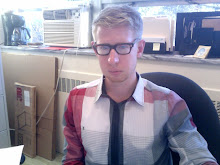
Candice Breitz was a visiting lecturer in the Photography and Film Dept. at VCU ealer this fall. A wonderful speaker, Breitz doesn’t fill her audiences with fluff about her work—she goes straight for the jugular. Her artworks essentially do the same thing: extract the human elements of pop culture that are often amiss in its presentation, via music videos, Hollywood films and television. In works such as Babel, Breitz isolates elemental sounds of grammar from pop music videos. For example, a clip of one of Madonna’s hits is condensed into the repeating gutterals “baaa baaa baaa.” In other extractions, Breitz selects whole words to repeat. And in her works Mother and Father, Breitz has extracted pop cultural iconographic mothers and fathers from Hollywood films and isolated them by blacking out their background environments. With most of her work existing in multi-channel formats, viewers are typically overwhelmed by so many isolated figures that are also part of one big conversation.
I am very attracted to Breitz’s work because it asks the essential question of “how are things interpreted when taken out of context?” and the more personal, “who are we when isolated from our environment?” In a modern age, we know ourselves as individuals, but so much of our identity is determined in how we are grouped socially and culturally. Another artist working with similar issues of misplaced context is Ellen Gallagher, who has isolated the hairdressing of African-Americans in white contexts. Gallagher layers cut-out yellow paper atop

advertisements of popular Afro hairstyles, in effect “blondeing” them all. A powerful, subversive, but quiet statement on assimilation.
I have delved into similar territory in my work with romance novels. For a brief period, I was obsessed with the cover figures of hetero romance novels. There is an evocative and disturbing cultural formula at play in this cover art. It is heteronormativity at its most
 grandiose, romantic base. In my Romance Series, I have separated the figures, man and woman from each other, subtracted facial features, and colored them in a ghostly pure white to erase any of the typically blushed, sexually-charged skin tones. I have attempted to take away their sexual substance. By physically separating these figures, I call into question the institutionalized notion of romantic love as something that only exists between straight couples: does such a romance exist in this day and age—did it ever really exist? In this body of work, I also challenge the Puritanically-based notions of monogamy. After separating the figures, I also place them in new social arrangements, often turned away from their pictured lover, sometimes without their original cover partner. I have placed them into different relationships: polyamorous groupings, queer couples, threesomes, etc.
grandiose, romantic base. In my Romance Series, I have separated the figures, man and woman from each other, subtracted facial features, and colored them in a ghostly pure white to erase any of the typically blushed, sexually-charged skin tones. I have attempted to take away their sexual substance. By physically separating these figures, I call into question the institutionalized notion of romantic love as something that only exists between straight couples: does such a romance exist in this day and age—did it ever really exist? In this body of work, I also challenge the Puritanically-based notions of monogamy. After separating the figures, I also place them in new social arrangements, often turned away from their pictured lover, sometimes without their original cover partner. I have placed them into different relationships: polyamorous groupings, queer couples, threesomes, etc.

2 comments:
I have a question about the end of the post (in which you write about your own work)...
It is a question that I have had in response to MANY people in my program, but I will pick on you and ask you -
Why the mixing of "romantic," "intimate," and "sexual"?
Why has our culture bastardized "romance" to also necessitate "sexual"?
Is it not possible to have a romantic involvement with someone without it being SEXUAL?
One quote someone said (and will remain nameless) - is that all my boyfriends with whom I did not have sex "did not count."
Is sex necessary for intimacy?
If so, why?
I would also be careful with delving into "romance novels" to indicate heterosexual intimacy ... I will admit, I do read these as candy for the brain from time to time ... there is very VERY little of actual "intimacy" to many of these novels. In fact, many synopses down right state that there was no reason for the two main characters to get together, except for their "passion," "heat," "desire."
Yes, a few romance novels still include the concept of falling in love - but many (and dare I say most) stick to falling in LUST.
So I repeat my question: Why, in American culture, is there a mixing of "romantic," "intimate," and "sexual"?
I believe that by dealing with these notions of love, romance, and sexuality through the romance novel, Aaron attempts to ask that question (or more specificaly, what is romance? love?) along with a host of others that challenge what our society has come to take for granted in this realm. Like Candice Breitz, by presenting a spin or queering (shout out, Aaron!) something we think we know or understand (like man and woman as the standard of relationships), we are asked to question the context from which we view the world and take into account other points of view which may be hidden or suppressed.
Post a Comment